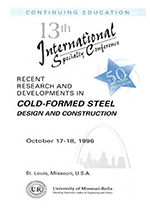Session Dates
17 Oct 1996
Abstract
The current use of cold-formed steel owes its success to efforts which started 50 years ago. In 1946 AISI published the first specification for the design of cold-formed (then known as light gage) steel structural members. The specification was the end product of a doctoral thesis by Dr. George Winter which was initiated in 1939. Since 1946 AISI has continually updated and modernized the AISI Specification for the Design of Cold-Formed Steel Structural Members. The 1956 manual was the first design specification to have a companion commentary. In 1991 AISI published the LRFD version of the Design of Cold-Formed Steel Structural Members. Today AISI is currently developing a single specification which combines the ASD and LRFD design methodologies.
Department(s)
Civil, Architectural and Environmental Engineering
Research Center/Lab(s)
Wei-Wen Yu Center for Cold-Formed Steel Structures
Meeting Name
13th International Specialty Conference on Cold-Formed Steel Structures
Publisher
University of Missouri--Rolla
Document Version
Final Version
Rights
© 1996 University of Missouri--Rolla, All rights reserved.
Document Type
Article - Conference proceedings
File Type
text
Language
English
Recommended Citation
Haws, Richard, "Steel - the Clear Cut Alternative" (1996). CCFSS Proceedings of International Specialty Conference on Cold-Formed Steel Structures (1971 - 2018). 2.
https://scholarsmine.mst.edu/isccss/13iccfss/13iccfss-session8/2
Steel - the Clear Cut Alternative
The current use of cold-formed steel owes its success to efforts which started 50 years ago. In 1946 AISI published the first specification for the design of cold-formed (then known as light gage) steel structural members. The specification was the end product of a doctoral thesis by Dr. George Winter which was initiated in 1939. Since 1946 AISI has continually updated and modernized the AISI Specification for the Design of Cold-Formed Steel Structural Members. The 1956 manual was the first design specification to have a companion commentary. In 1991 AISI published the LRFD version of the Design of Cold-Formed Steel Structural Members. Today AISI is currently developing a single specification which combines the ASD and LRFD design methodologies.



